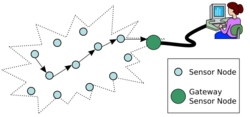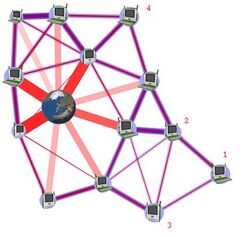Multi-hop routing
Topic: Engineering
 From HandWiki - Reading time: 1 min
From HandWiki - Reading time: 1 min

A typical multi-hop wireless sensor network architecture

A wireless mesh network architecture allowing otherwise out-of-range nodes 1–4 to still connect to the Internet. A key characteristic is the presence of multiple-hop links and using intermediate nodes to relay packets for others.
Multi-hop routing (or multihop routing) is a type of communication in radio networks in which network coverage area is larger than radio range of single nodes. Therefore, to reach some destination a node can use other nodes as relays.[1]
Since the transceiver is the major source of power consumption in a radio node and long distance transmission requires high power, in some cases multi-hop routing can be more energy efficient than single-hop routing.[2]
Typical applications of multi-hop routing:
- Wireless sensor networks
- Wireless mesh networks
- Mobile ad hoc networks
- Smart phone ad hoc networks
- Mobile networks with stationary multi-hop relays
References
- ↑ Pešović, Uroš M.; Mohorko, Jože J.; Benkič, Karl; Čučej, Žarko F. (23–25 November 2010). "Single-hop vs. Multi-hop – Energy efficiency analysis in wireless sensor networks". Srbija, Beograd: Telekomunikacioni forum TELFOR 2010. pp. 471–474. http://2010.telfor.rs/files/radovi/TELFOR2010_03_42.pdf. Retrieved 2 June 2017.
- ↑ Fedor, Szymon; Collier, Martin (2007). "On the problem of energy efficiency of multi-hop vs one-hop routing in Wireless Sensor Networks". 21st International Conference on Advanced Information Networking and Applications Workshops (AINAW'07). https://core.ac.uk/download/pdf/11309673.pdf.
 |
Licensed under CC BY-SA 3.0 | Source: https://handwiki.org/wiki/Engineering:Multi-hop_routing10 views | Status: cached on August 13 2024 09:14:13↧ Download this article as ZWI file
 KSF
KSF